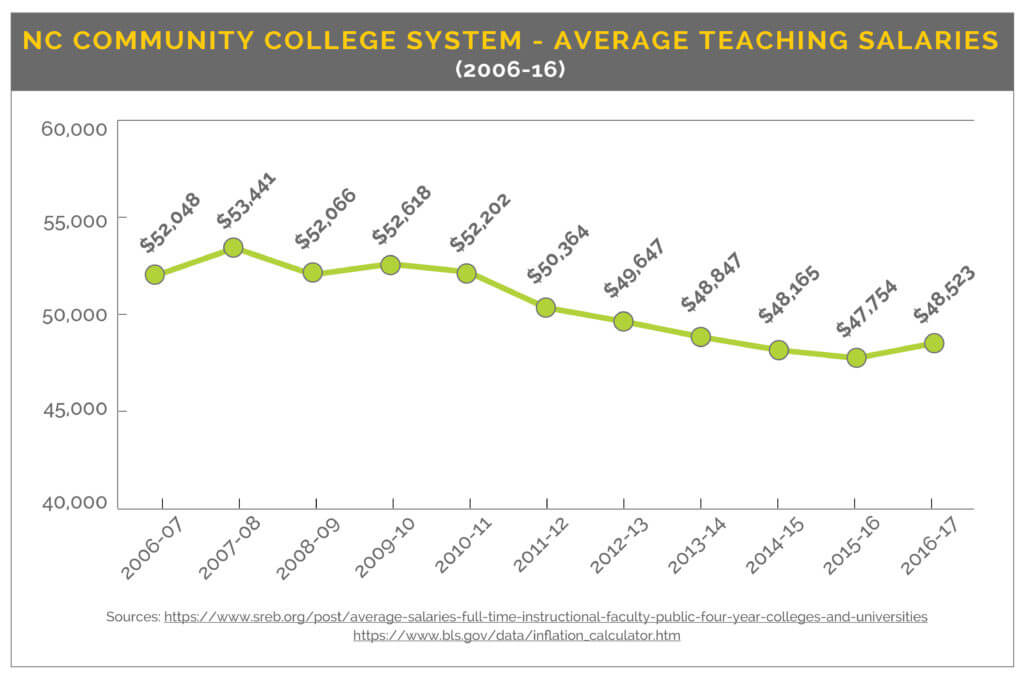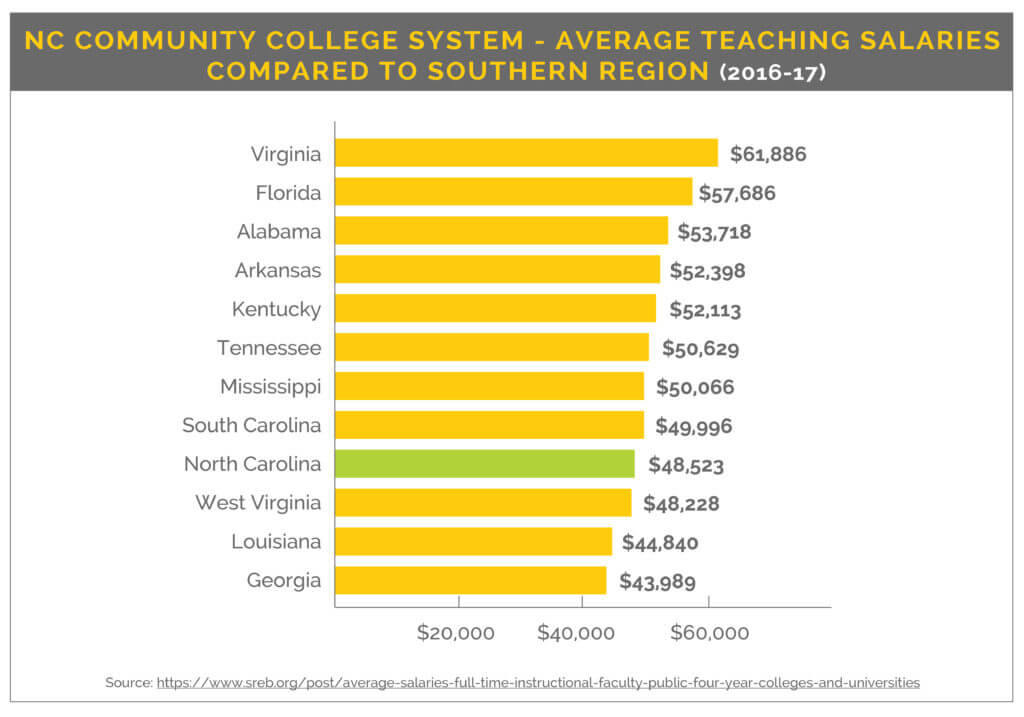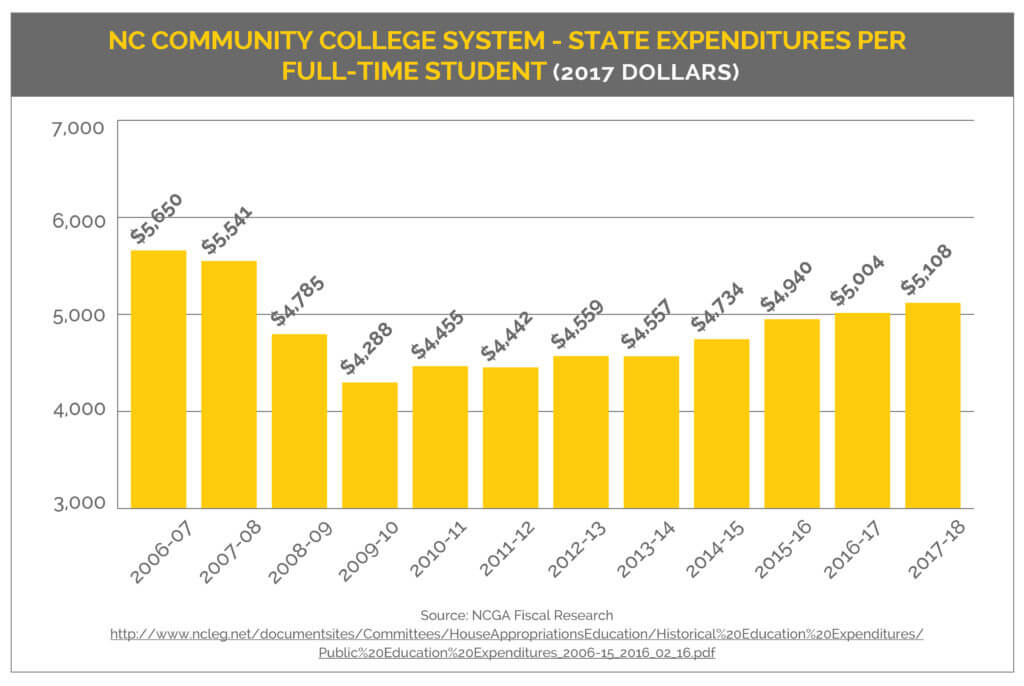
RALEIGH – Community colleges are critically important to North Carolina’s workforce.
At a time when 67 percent of jobs in North Carolina are projected to require education beyond high school by 2020,1 community colleges offer a more-affordable path to a degree, job-specific training and training for the trades.
And North Carolinians love their community colleges – System President Peter Hans likes to point out that about 700,000 students are enrolled at the state’s community colleges.
Yet we don’t always show them the love come budget time.
As with our public universities, state spending on community colleges has remained largely flat since the Great Recession.

In fact, full-time instructors at NC community colleges make less on average than K-12 public school teachers – in 2016-17, their pay averaged just $48,523. North Carolina K-12 teachers averaged $50,698 in 2016-17.2
Nor has pay for community-college instructors kept pace with either inflation or our neighboring states.

If North Carolina invested in community-college instructors, perhaps its funding wouldn’t appear so flat.
A look at community-college faculty salaries across the Southeast reveals that North Carolina ranks below Tennessee, Mississippi and South Carolina – and more than $13,000 behind region-leading Virginia.

Scott Ralls, President of Wake Technical Community College and former President of the NC Community College System, has seen challenges to hiring and retaining faculty at a variety of colleges. In high-demand fields like nursing, he says, a graduate can make as much as their instructor.
“Someone can walk out of a program and make as much as their instructor does – that’s where the challenge comes,” Ralls said.
When he was President of Craven Community College, Ralls said, a vacancy for a nursing instructor once went unfilled for a year. “Nobody would accept the job at what we were offering,” he said.
Colleges need and do have flexibility to shift funds to raise salaries in high-demand fields, he said, noting that graduates in cybersecurity can quickly make $100,000 or more.
Ralls said he had a humbling experience during a recent visit with an information-technology executive. What the college pays its instructors on average is what the IT company pays its employees on entry, he said.
STATE EXPENDITURES per student at community colleges have risen slightly since the Great Recession – but they have not returned to pre-recession levels.

Enrollment at community colleges tends to be counter-cyclical: When the economy is good, folks go to work. But when it turns sour, folks tend to go back to school to improve their skills – especially if they’ve been laid off.
That’s why NC community colleges saw an extraordinary 23 percent spike in enrollment during the Great Recession.3
So thanks to a strong North Carolina economy, our state’s community colleges saw a decrease of the equivalent of 1,957 full-time students in 2018.4
Both the NC House and Senate versions of the budget for 2019-20 further reduce community-college funding by $4.5 million to reflect a further decrease in enrollment this year of 4,089 students, or 1.7%.
But the House provides $8 million in its version of the budget and the Senate $12 million in additional funding for short-term workforce training,5 a priority of the State Board of Community Colleges and a step in the right direction.
1Georgetown Center on Education and the Workforce, https://1gyhoq479ufd3yna29x7ubjn-wpengine.netdna-ssl.com/wp-content/uploads/StateProjections_6.1.15_agc_v2.pdf, pp. 3, 76-77.
2https://hew.aveltsagency.com/2019/06/nc-teacher-raises/.
3https://hew.aveltsagency.com/2018/09/community-colleges/.
4https://www.ncleg.gov/Sessions/2017/Budget/2018/conference_committee_report_2018_05_28.pdf, p. B20.
5https://www.ncleg.gov/Sessions/2019/Budget/2019/Committee_Report_Senate_Appropriation_Base_Budget_PCS_May_29_2019.pdf, pp. B7, B9;
https://www.ncleg.gov/Sessions/2019/Budget/2019/AllCommitteeReport_ForFloor_2019_05_01.pdf, pp. B7, B9.

Leave a Reply